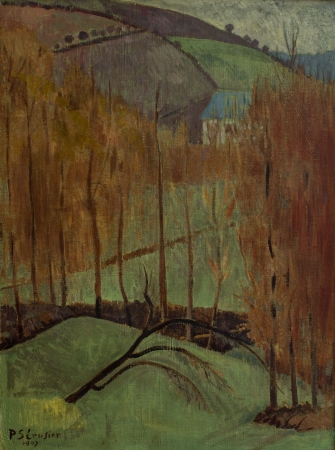SÉRUSIER, Hill with Poplars

Paul SÉRUSIER (1864-1927)
Hill with Poplars
1907
oil on canvas
73.3 x 54.4 cm
© MuMa Le Havre / David Fogel
Hill with Poplars
1907
oil on canvas
73.3 x 54.4 cm
© MuMa Le Havre / David Fogel
HD image
podcast
Convinced that the straight line was purely a human invention, Sérusier endeavoured to show, through the undulating verticals of poplar boles, that nature works in curves. The artist thus composed by alternating between essential geometric motifs and happy accidents of nature, sometimes at the risk of provoking them.
Colour is given the same clever orchestration. With a matte finish that strives to achieve the harmony of greys of the old masters, he makes use of a dual palette, according to a principle long held in his work and regularly confirmed by his successive attempts to establish a colour circle. The cool colours with dominant greens and warm colours based on ochre create the overall atmosphere, that of a late autumn landscape. However, fully aware that he is engaging in the act of painting and not slavishly copying nature, Sérusier introduces discordances meant to exalt the colours. The yellow spot at the base of the dead branch has no purpose other than to increase the painting's luminosity.
In Hill with Poplars, six essential colours come into play: ochre, green, yellow, blue grey, pink and black, bathing the landscape in autumn light. For the application of colour, Sérusier used a technique similar to glazes to achieve the effect of the old masters. After preparing the canvas, it was evenly covered with the dominant green shade. The different layers of colours were then superimposed, while still allowing the overall harmony to seep through. By using this delicate treatment, Sérusier was able to create effects of transparency and depth, a quality that could not be developed through the Synthetism of the Nabi period.
Colour is given the same clever orchestration. With a matte finish that strives to achieve the harmony of greys of the old masters, he makes use of a dual palette, according to a principle long held in his work and regularly confirmed by his successive attempts to establish a colour circle. The cool colours with dominant greens and warm colours based on ochre create the overall atmosphere, that of a late autumn landscape. However, fully aware that he is engaging in the act of painting and not slavishly copying nature, Sérusier introduces discordances meant to exalt the colours. The yellow spot at the base of the dead branch has no purpose other than to increase the painting's luminosity.
In Hill with Poplars, six essential colours come into play: ochre, green, yellow, blue grey, pink and black, bathing the landscape in autumn light. For the application of colour, Sérusier used a technique similar to glazes to achieve the effect of the old masters. After preparing the canvas, it was evenly covered with the dominant green shade. The different layers of colours were then superimposed, while still allowing the overall harmony to seep through. By using this delicate treatment, Sérusier was able to create effects of transparency and depth, a quality that could not be developed through the Synthetism of the Nabi period.
















